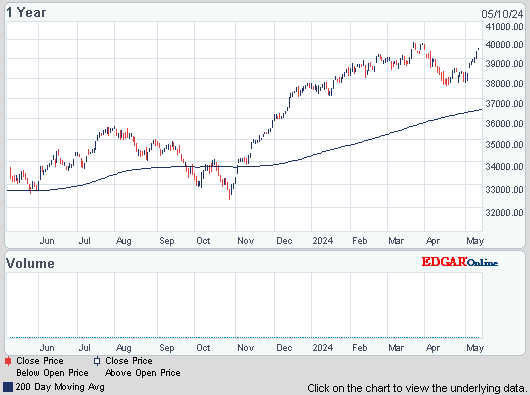Dow gained 106, advancers over decliners 3-1 & NAZ added 27. The MLP index was up 2 to the 456s & the REIT index rose 2 to the 301s. Junk bond funds drifted lower & Treasuries yields continued near 5 month lows. Oil rose
to the highest level in more than 2 weeks on optimism that
central banks will maintain economic stimulus to bolster growth. Gold was up on speculation
that the Federal Reserve will maintain bond purchases to bolster
the US economy, while demand for coins & jewelry climbed.
AMJ (Alerian MLP Index tracking fund)

![Live 24 hours gold chart [Kitco Inc.]](http://www.kitco.com/images/live/gold.gif)

China isn't the country's biggest creditor, America is. The bulk of the national debt, soon to exceed a staggering $17T, is held by the Federal Reserve, Social Security system, various pension plans for civil service workers & military personnel, US banks, mutual funds, private pension plans, insurance companies & individual domestic investors. China is responsible for just a shade over 7% of that total debt & while it remains the single largest foreign lender (just ahead of Japan), China's been slowly trimming its holdings, down from nearly 10% a few years ago. Overall, all foreign investors, including national central banks, account for roughly 1/3 of the total outstanding federal gov debt. Also, China is suddenly having debt problems of its own. Heavy recent lending by its banks comes as the recovery in the world's 2nd-largest economy seems to be stalling. The export giant posted a rare trade deficit in Mar. The national debt will soon be front-and-center again as a deeply divided DC wrestles with an expected new administration request to increase the Treasury's borrowing authority, the legislatively set debt ceiling. The higher limit would not authorize borrowing for new spending but just enables the gov to pay all the bills already racked up! The upcoming summer debate could be a repeat of the divisive debt-ceiling crisis in Aug 2011 when weeks of political irresolution nearly plunged the US into its first-ever financial default, & did trigger a downgrade in the its once-sterling credit rating. The Reps say the only way the House will go along with raising the country's borrowing ceiling was if the pres & the Dems came up with a "dollar-for-dollar" amount in budget cuts.
US loans from China at issue in debt-ceiling fight A
The Federal Reserve (FED) may shift discussion away from when to reduce monetary stimulus, given data showing the economy is weakening, according to Pacific Investment Management's Mohamed A. El-Erian. “The inherent momentum of the economy is still weak and you don’t want to taper off too quickly,” El-Erian said. “They are going to try to change the narrative away from the Fed is taking its foot off the accelerator, to the Fed is maintaining its foot on the accelerator. It could even press it harder.” The FED is buying $85B of Treasury & mortgage debt a month to support the economy by putting downward pressure on borrowing costs. The central bank spent $2.3T in 2008-2011 during the first 2 rounds of quantitative easing. GDP rose at a 2.5% annual rate Q1, below the 3% estimate. It is forecast to keep its interest-rate target at zero to 0.25% & continue its bond-buying after this week's meeting. El-Erian also noted the risks in the record amount of stimulus injected in the economy. “The benefits of the Fed come with costs and risks,” he said. “What I worry about is when you run a system at artificial price levels, you start creating damage, resources are misallocated, too much risk is taken.””
Fed May Shift Talks Toward More Stimulus, El-Erian Says
Treasury 10-year-note yields traded at almost the lowest this year as US personal spending slowed last month, signaling reduced economic growth & underpinning demand for the securities. The benchmark 10-year Treasuries gained for a 2nd day as a report showed household purchases rose 0.2% in Mar, compared with a 0.7% increase the previous month. The yield dropped on Fri, by the most in 2 weeks, as a report showed the US economy expanded less than economists predicted. The yield fell to as low as 1.64% last Tues, the lowest since Dec 12. The yield on the 30-year bond traded at 2.86%. Inflation measured by the personal consumption expenditures index, a gauge preferred by the FED, rose 1.1% in Mar from a year earlier, compared with 1.3% the previous month, according to the Commerce Dept. The figure is less than the central bank’s goal of 2% & the slowest growth in inflation since Mar 2011, favoring a continuation of low interest rates..
Treasury 10-Year Yield at Almost 2013 Low as U.S. Spending Slows
Stocks are in demand again without any significant news to support the buying. There is a "feeling" that everything will turn out just fine as growth continues. But growth has been drab since the recession ended in 2009 & Q1 data was less than inspiring. US consumers appear to be a little more cautious with all the confusing signals (like higher taxes) coming from DC. The budget battle (spend less vs let the future take care of itself) shows no sign of ending & raising the debt ceiling will have to be dealt with in a couple of months. But Dow is within 47 of setting a new record as if it didn't have a care in the world. The big winners in the Dow today with at least 2% gains were: Hewlett-Packard (HPQ), Microsoft (MSFT), IBM (IBM) & DuPont (DD). However, the 10 year Treasury bond has had quite a gain since the 2nd week of Mar (bets against rising stocks).
Dow Jones Industrials

AMJ (Alerian MLP Index tracking fund)
Treasury yields:
U.S. 3-month |
0.048% | |
U.S. 2-year |
0.209% | |
U.S. 10-year |
1.668% |
| CLM13.NYM | ...Crude Oil Jun 13 | ...94.49 | (1.6%) |
![Live 24 hours gold chart [Kitco Inc.]](http://www.kitco.com/images/live/gold.gif)

China isn't the country's biggest creditor, America is. The bulk of the national debt, soon to exceed a staggering $17T, is held by the Federal Reserve, Social Security system, various pension plans for civil service workers & military personnel, US banks, mutual funds, private pension plans, insurance companies & individual domestic investors. China is responsible for just a shade over 7% of that total debt & while it remains the single largest foreign lender (just ahead of Japan), China's been slowly trimming its holdings, down from nearly 10% a few years ago. Overall, all foreign investors, including national central banks, account for roughly 1/3 of the total outstanding federal gov debt. Also, China is suddenly having debt problems of its own. Heavy recent lending by its banks comes as the recovery in the world's 2nd-largest economy seems to be stalling. The export giant posted a rare trade deficit in Mar. The national debt will soon be front-and-center again as a deeply divided DC wrestles with an expected new administration request to increase the Treasury's borrowing authority, the legislatively set debt ceiling. The higher limit would not authorize borrowing for new spending but just enables the gov to pay all the bills already racked up! The upcoming summer debate could be a repeat of the divisive debt-ceiling crisis in Aug 2011 when weeks of political irresolution nearly plunged the US into its first-ever financial default, & did trigger a downgrade in the its once-sterling credit rating. The Reps say the only way the House will go along with raising the country's borrowing ceiling was if the pres & the Dems came up with a "dollar-for-dollar" amount in budget cuts.
US loans from China at issue in debt-ceiling fight A
The Federal Reserve (FED) may shift discussion away from when to reduce monetary stimulus, given data showing the economy is weakening, according to Pacific Investment Management's Mohamed A. El-Erian. “The inherent momentum of the economy is still weak and you don’t want to taper off too quickly,” El-Erian said. “They are going to try to change the narrative away from the Fed is taking its foot off the accelerator, to the Fed is maintaining its foot on the accelerator. It could even press it harder.” The FED is buying $85B of Treasury & mortgage debt a month to support the economy by putting downward pressure on borrowing costs. The central bank spent $2.3T in 2008-2011 during the first 2 rounds of quantitative easing. GDP rose at a 2.5% annual rate Q1, below the 3% estimate. It is forecast to keep its interest-rate target at zero to 0.25% & continue its bond-buying after this week's meeting. El-Erian also noted the risks in the record amount of stimulus injected in the economy. “The benefits of the Fed come with costs and risks,” he said. “What I worry about is when you run a system at artificial price levels, you start creating damage, resources are misallocated, too much risk is taken.””
Fed May Shift Talks Toward More Stimulus, El-Erian Says
Treasury 10-year-note yields traded at almost the lowest this year as US personal spending slowed last month, signaling reduced economic growth & underpinning demand for the securities. The benchmark 10-year Treasuries gained for a 2nd day as a report showed household purchases rose 0.2% in Mar, compared with a 0.7% increase the previous month. The yield dropped on Fri, by the most in 2 weeks, as a report showed the US economy expanded less than economists predicted. The yield fell to as low as 1.64% last Tues, the lowest since Dec 12. The yield on the 30-year bond traded at 2.86%. Inflation measured by the personal consumption expenditures index, a gauge preferred by the FED, rose 1.1% in Mar from a year earlier, compared with 1.3% the previous month, according to the Commerce Dept. The figure is less than the central bank’s goal of 2% & the slowest growth in inflation since Mar 2011, favoring a continuation of low interest rates..
Treasury 10-Year Yield at Almost 2013 Low as U.S. Spending Slows
Stocks are in demand again without any significant news to support the buying. There is a "feeling" that everything will turn out just fine as growth continues. But growth has been drab since the recession ended in 2009 & Q1 data was less than inspiring. US consumers appear to be a little more cautious with all the confusing signals (like higher taxes) coming from DC. The budget battle (spend less vs let the future take care of itself) shows no sign of ending & raising the debt ceiling will have to be dealt with in a couple of months. But Dow is within 47 of setting a new record as if it didn't have a care in the world. The big winners in the Dow today with at least 2% gains were: Hewlett-Packard (HPQ), Microsoft (MSFT), IBM (IBM) & DuPont (DD). However, the 10 year Treasury bond has had quite a gain since the 2nd week of Mar (bets against rising stocks).
Dow Jones Industrials










No comments:
Post a Comment